How To Make An Easy DIY Leather Plant Hanger
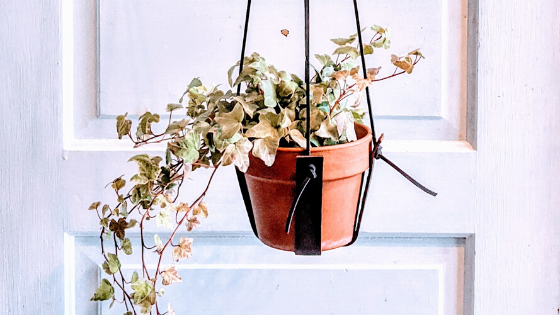
The snow is melting, the sun is shining, the air is warming, and Spring is here! Up here in Minnesota, we’ve got quite a bit of time before we start seeing things bloom again, but we appreciate the sun on our faces nonetheless.
If you’re feeling impatient about seeing some spring color, a hanging plant just may do the trick of brightening up your home decor after a long winter.
Leather plant hangers have been popping up everywhere this season. So have macrame plant hangers, but that is a little outside my purview. I will have some recommendations for how to incorporate it should you want to!
This is a simple spring DIY project you can do in an afternoon, and I am including the time it takes running to your local home improvement store to get new plants and pots! And truthfully, you could do this anytime of year that you just want a bit more greenery in your house.
Supplies needed for your hanging planter:
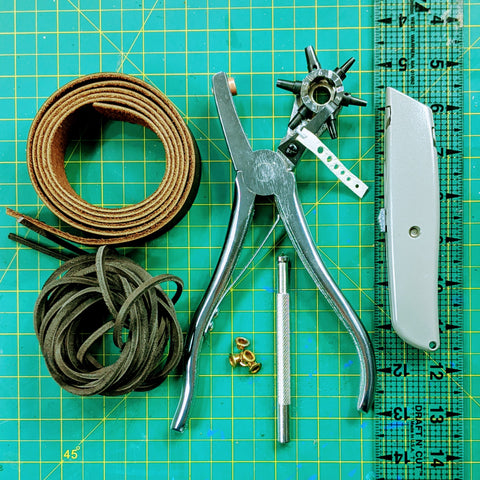
Leather Straps (we used our pre-cut ¾” wide straps)
Leather Cowhide Lace (2-4 pieces depending on how long you want your plant hanger to be.)
Leather Fastener (we used grommets, but you could use rivets or chicago screws)
Utility Blade or good quality Scissors
Ruler
Planters and plants of your choosing
Once you have all your supplies together, you can get to work!
To start, take out your planter or pot that you want to put in the hanger. You’ll want to use it for reference when deciding how long or short to cut your leather straps.
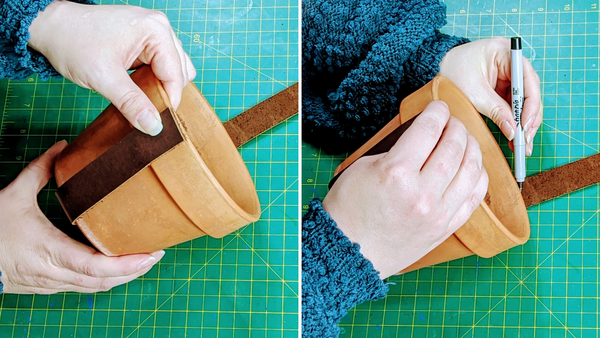
Set the pot on one of the leather straps and pull up the sides. When you’ve decided whether you want the strap to sit above or below the rim of the pot, mark your choice with a pencil.
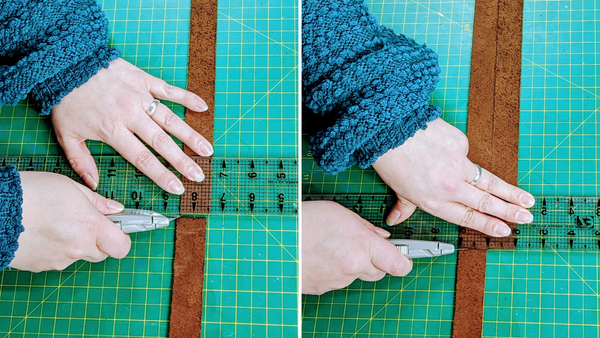
When you’re happy with the length and where your marks are, go ahead and cut the strap down. Use that piece as the template to cut your second piece.

Once you have two identical straps cut, mark their centers. This is where you are going to fasten them together so they will safely hold your planter.
Using your hole punch, create a hole large enough for the fastener you have selected to fit through. Using either a grommet or a rivet will work great for this project! A Chicago screw would also work, depending on how thick your leather is.
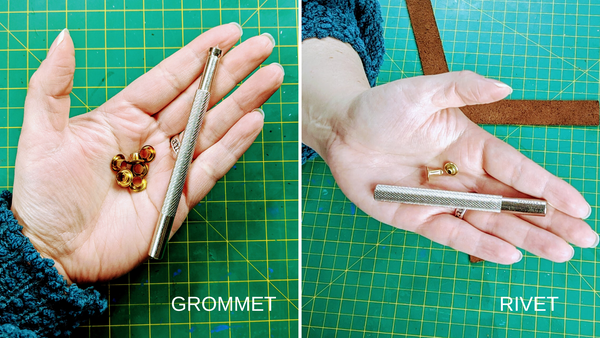
Lay your leather pieces in the shape of a cross or plus sign. You’ll want 90-degree angles to ensure the straps are spaced evenly when holding your planter. If you measured your center hole punches correctly, they should line right up!

Take your fastener, and put the post through both straps. Using the setting tool, go ahead and close up your rivet or grommet.
Make sure to try and keep your straps at the right angles. Once you’ve secured them with the fastener, it’s a bit harder to move them back. Take your time with setting them!

Now we are going to punch holes on the outside ends of our straps to run the lace through.
Again, find your center on your strap and decide how far in you want your lace to sit. Make sure not to punch your hole too close to the edge. Remember that this will be holding a pot, potting soil, a plant, and water weight every time you water said plant. Punching a hole too close to the edge may make the leather too weak to hold the weight against the lace.
Mark your chosen spot, then repeat that measurement on the other ends. I went a quarter of an inch down from the edge. When you've made your decision, go ahead and punch those holes.
Now, before you tie up your lace, you have to decide how low you want your plant hanger to hang. If you only bought two laces, your hanger will only be as long as the laces are folded in half. So a 72” lace will hang down about 32” once you account for the knots and the angle.
If you want a much longer hanger, consider buying 4 laces and knotting them to each hole on the hanger individually. Then you can adjust the length as you see fit, loop all four together in a large lovely knot, and trim the excess once you’ve hung it up and balanced it.
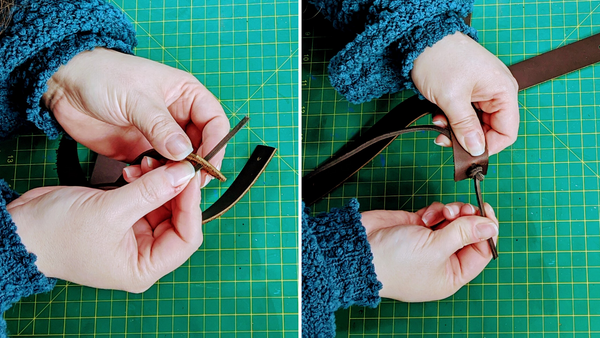
When you've decided the length you want your hanger to be, slip your lace through the holes you punched, and tie a knot. Make it a simple knot or a decorative knot, the choice is up to you! You could even add a bead or some other kind of decoration.
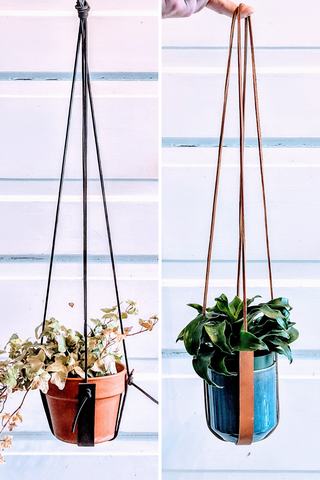
This would also be a great time to incorporate some of the macrame I mentioned earlier. If you have some lovely rope or twine, and want to braid, wind, or weave it, then attach it to your leather in lieu of the leather lace, go for it! Add some beads or other details.
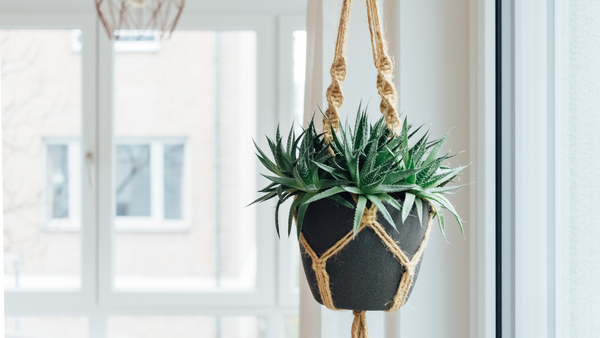
You could even buy a bundle of leather lace and braid those together instead of using single threads or twine. It's a little more tricky due to the thickness of leather, but leatherworkers have been braiding leather since the dawn of time so give it a shot!
A simple leathercraft is very easy to make more complex. Make the first one exactly as I did. Once you finish, you’re sure to see a million ways you’d like to add to and improve upon the method.
Personally, I like the simple look, because I hang a lot of plants in my window, and the simpler design of hangers allows for the plants to be the stars! However, a friend of mine has an entire window filled with wild and over the top white macrame planters that are just absolutely stunning.
Make your project suit your style! Consider this an entry-level project. If you’re thrilled with the results, marvel at your handy work. If this opens up a new leatherworking passion, make this simple design something extra with your own choices and details!
Then share your plant holders with us. We love to see your leather projects on social media or via email. Now go hang up your planter and enjoy the greenery and fresh air.
P.S. Using genuine leather on a project where it may be exposed to water, could lead to some discoloration or damage to the leather. If you are worried about your plant leaking onto your straps excessively, consider sealing the backside/suede with Resolene to keep moisture out. Oil-tanned leather (like the straps used in this how-to, do not need to be coated on the finished side, just conditioned occasionally.

